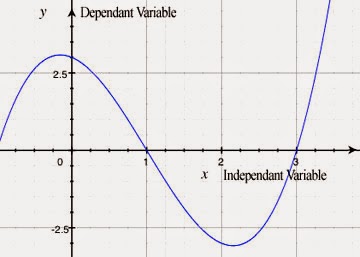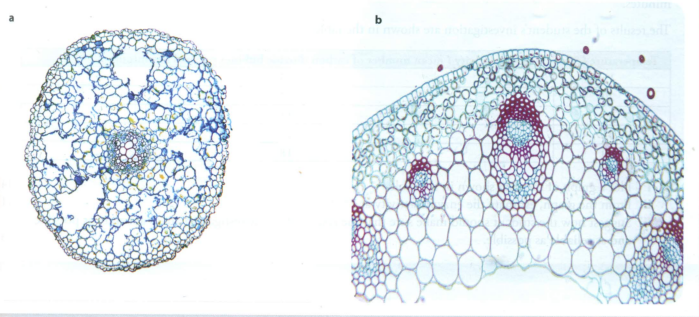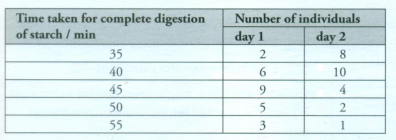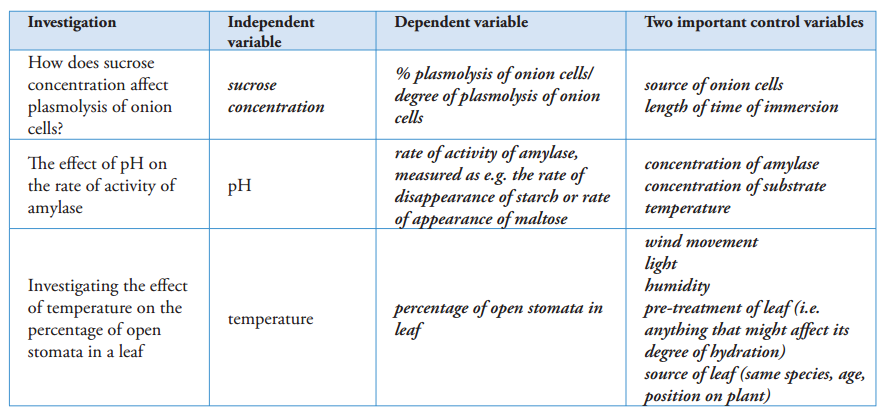Biology
 1 In an experiment investigating the effect of one variable on another, the independent variable is the one that you change and the dependent variable is the one that you measure. All other variables should be controlled (kept constant).
1 In an experiment investigating the effect of one variable on another, the independent variable is the one that you change and the dependent variable is the one that you measure. All other variables should be controlled (kept constant).
2 The range of the independent variable is the spread from lowest to highest value. The interval is the distance between each value in the range.
3 Temperature can be kept constant or varied using a water bath. pH can be kept constant or varied using buffer solutions.
4 The accuracy of a measurement is how true it is. For example, an accurate measuring cylinder reads exactly 50 cm3 when it contains 50 cm3 of liquid.c
5 The precision of a measuring instrument is how consistent it is in giving exactly the same reading for the same value.
6 The reliability of a set of measurements is the degree of trust that you can have in them. A reliable set of measurements are likely to be very similar if you are able to do the same experiment again. If you are concerned about reliability, then do at least three repeat measurements for each value of your
independent variable, and calculate a mean.
7 In general, the error in any measurement is half the value of the smallest division on the scale. For
example, on a measuring cylinder marked in 2 cm3 divisions, the error in any reading will be ± 1cm3. If you are taking two readings and calculating the diff erence between them, then the error is ± 1 cm3 for each reading, making a total error of ± 2 cm3.
8 Results tables should be constructed with the independent variable in the first column and the
readings for the dependent variable(s) in the next column(s). Units go in the headings, not in the body
of the table. Each value should be recorded to the same number of decimal places. This is also the case for any calculated values.
9 In a line graph, the independent variable goes on the x-axis and the dependent variable on the y-axis. Headings must include units. Scales must go up in even and sensible steps. Points should be plotted as small crosses or as encircled dots. Lines should be best fit or ruled between successive points. Do not extrapolate.
10 Bar charts are drawn when there is a discontinuous variable on the x-axis. Bars do not touch.
11 Frequency diagrams or histograms are drawn when there is a continuous variable on the x-axis. Bars touch.
12 Conclusions should be short and to the point. They should use the results to answer the question posed by the investigation. They should not go beyond what is shown by the results. Do not confuse
conclusion with discussion.
13 When describing data displayed on a graph, begin by stating the general trend and then describe any points at which the gradient of the curve changes. Quote figures from the x-axis and y-axis coordinates for these points. Do not use language suggesting time (e.g. ?faster?) if time is not shown on the x-axis or y-axis.
14 Show every small step whenever you are asked to do a calculation.
15 Do not confuse mistakes with experimental errors. Mistakes should not happen. Experimental
errors are often unavoidable, unless you have the opportunity to use a better technique or better
apparatus. Systematic errors are those which have the same magnitude and direction throughout the
experiment, and are usually caused by limitations in the measuring instruments. Random errors are
those which vary in magnitude and direction during the experiment, and may be caused by difficulty
in controlling variables or in making judgements. When asked to suggest improvements in an experiment, concentrate on the main sources of error and suggest ways of reducing them.
16 When making drawings from a microscope, a low-power plan should show only the outlines of
tissues and no individual cells. Be prepared to go up to high power to get more information about where one tissue ends and another begins. High-power drawings should show as much detail as possible, including details of individual cells.
An investigation is carried out into the effect of substrate concentration on the activity of catalase. What could be the dependent variable?
A the concentration of catalase
B the pH of the enzyme solution
C the rate of production of oxygen
D the temperature of the substrate





iv no. of squares of graph paper covered by whole root section counted; [1]
v % squares occupied by lignifi ed tissue in root calculated correctly from student?s
answers to iii and iv; (answer should be around 1%) [1]
vi no. of squares covered by lignifi ed tissue in stem counted;
no. of squares covered by whole stem counted;
% squares occupied by lignifi ed tissue in stem calculated correctly; (answer should
be around 1%) [3]
vii stem needs more support than root;
because upright in air and needs support to prevent it falling over / collapsing; AW [2]
viii roots subjected to tugging/pulling pressure from parts above ground;
roots spread out, so like a series of guy ropes;
stem a single column;
greater strength from a ring of rods than from one central rod;
ring of rods provides greater resistance to compression from above than a single central rod;
accept any reasonable suggestion(s) which are based on diff erent stresses to which roots and
stems are subjected. [max.2]
5 a i ?Temperature / °C? on x-axis and ?Enzyme activity / mean number of carbon dioxide
bubbles released per minute? on y-axis;
suitable scales on both axes ? range from 10 or 15 to 40 on x-axis and 0 or 5 to 20 on
y-axis, in intervals of 2 or 5;
all points plotted accurately, using crosses or encircled dots;
thin, clear, best-fi t line drawn or points joined with ruled lines ? no extrapolation; [4]
ii correct reading from graph, including unit (mean number of bubbles per minute); [1]
iii accuracy: use water bath to change independent variable;
control of signifi cant named variable plus method of control (e.g. use same type of yeast);
use named apparatus (e.g. gas syringe) to collect gas (for measurement of dependent
variable);
reliability: increase number/range of temperatures;
repeat each temperature three times and calculate mean; [max. 3]
b hypothesis is supported;
quote figures for change in mean number of bubbles between any two temperatures between
15 °C and 40 °C;
reference to no data below 15 °C or above 40 °C;
so cannot tell if hypothesis is also supported outside this range; [max. 2]
6 a x-axis is ?Time / minutes?, y-axis is ?Number of individuals?;
scales on both axes with suitable range and interval;
all bars plotted accurately or points plotted accurately (using a cross or an encircled dot);
all lines neat and thin, plus key; [4]
b on both days, minimum time taken is 35 min and maximum time taken is 55 min;
on both days, number of individuals is greatest near the centre of the range;
on day 1, greatest number of individuals take 45 minutes to digest starch, but on day 2 greatest number of individuals take 10 minutes to digest starch;
mean time is greater on day 1 than on day 2; [max. 3]
c temperature may have been higher on day 2;
animals on day 2 may have eaten recently and so had more saliva/amylase in their mouths; [max. 1]
d use individuals of same age/mass/body weight;
ensure pre-treatment is the same (e.g. food given, environment);
use same volume of saliva;
use same volume and concentration of starch;
keep temperature the same by using a water bath; [max. 3]
- #74 Identifying Sources Of Error
It is very important to understand the difference between experimental errors and 'mistakes'. A mistake is something that you do incorrectly, such as misreading the scale on a thermometer, or taking a reading at the wrong time, or not emptying...
- #71 Recording Measurements And Other Data
You will often need to construct a table in which to record your measurements, readings and other observations. It is always best to design and construct your results table before you begin your experiment, so that you can write your readings...
- #70 Practical Exam - Taking Measurements
You will often be asked to take measurements or readings. In biology, these are most likely to be length, mass, time, temperature or volume. You could be taking readings from a linear scale (for example, reading temperature on a thermometer, reading...
- #69 How To Get High Marks In Paper 3 - Variables
Many of the experiments that you will do during your AS course, and usually Question 1 in the examination paper, will investigate the effect of one factor on another. These factors are called variables. Types of variables The factor that you change...
- #22 Summary Of Enzymes
1 Enzymes are globular proteins which catalyse metabolic reactions. 2 Each enzyme has an active site with a specific shape, into which the substrate molecule or molecules fit precisely. This is the lock and key hypothesis ? the substrate is...
Biology
#76 Summary of Practical Skills
 1 In an experiment investigating the effect of one variable on another, the independent variable is the one that you change and the dependent variable is the one that you measure. All other variables should be controlled (kept constant).
1 In an experiment investigating the effect of one variable on another, the independent variable is the one that you change and the dependent variable is the one that you measure. All other variables should be controlled (kept constant).2 The range of the independent variable is the spread from lowest to highest value. The interval is the distance between each value in the range.
3 Temperature can be kept constant or varied using a water bath. pH can be kept constant or varied using buffer solutions.
4 The accuracy of a measurement is how true it is. For example, an accurate measuring cylinder reads exactly 50 cm3 when it contains 50 cm3 of liquid.c
5 The precision of a measuring instrument is how consistent it is in giving exactly the same reading for the same value.
6 The reliability of a set of measurements is the degree of trust that you can have in them. A reliable set of measurements are likely to be very similar if you are able to do the same experiment again. If you are concerned about reliability, then do at least three repeat measurements for each value of your
independent variable, and calculate a mean.
7 In general, the error in any measurement is half the value of the smallest division on the scale. For
example, on a measuring cylinder marked in 2 cm3 divisions, the error in any reading will be ± 1cm3. If you are taking two readings and calculating the diff erence between them, then the error is ± 1 cm3 for each reading, making a total error of ± 2 cm3.
8 Results tables should be constructed with the independent variable in the first column and the
readings for the dependent variable(s) in the next column(s). Units go in the headings, not in the body
of the table. Each value should be recorded to the same number of decimal places. This is also the case for any calculated values.
9 In a line graph, the independent variable goes on the x-axis and the dependent variable on the y-axis. Headings must include units. Scales must go up in even and sensible steps. Points should be plotted as small crosses or as encircled dots. Lines should be best fit or ruled between successive points. Do not extrapolate.
10 Bar charts are drawn when there is a discontinuous variable on the x-axis. Bars do not touch.
11 Frequency diagrams or histograms are drawn when there is a continuous variable on the x-axis. Bars touch.
12 Conclusions should be short and to the point. They should use the results to answer the question posed by the investigation. They should not go beyond what is shown by the results. Do not confuse
conclusion with discussion.
13 When describing data displayed on a graph, begin by stating the general trend and then describe any points at which the gradient of the curve changes. Quote figures from the x-axis and y-axis coordinates for these points. Do not use language suggesting time (e.g. ?faster?) if time is not shown on the x-axis or y-axis.
14 Show every small step whenever you are asked to do a calculation.
15 Do not confuse mistakes with experimental errors. Mistakes should not happen. Experimental
errors are often unavoidable, unless you have the opportunity to use a better technique or better
apparatus. Systematic errors are those which have the same magnitude and direction throughout the
experiment, and are usually caused by limitations in the measuring instruments. Random errors are
those which vary in magnitude and direction during the experiment, and may be caused by difficulty
in controlling variables or in making judgements. When asked to suggest improvements in an experiment, concentrate on the main sources of error and suggest ways of reducing them.
16 When making drawings from a microscope, a low-power plan should show only the outlines of
tissues and no individual cells. Be prepared to go up to high power to get more information about where one tissue ends and another begins. High-power drawings should show as much detail as possible, including details of individual cells.
End-of-chapter questions
An investigation is carried out into the effect of substrate concentration on the activity of catalase. What could be the dependent variable?
A the concentration of catalase
B the pH of the enzyme solution
C the rate of production of oxygen
D the temperature of the substrate
2 An investigation is carried out into the effect of temperature on the activity of lipase. Separate tubes of substrate solution and enzyme solution are left in temperature-controlled water baths for ten minutes before mixing. Why is this done?
A to activate the enzyme
B to allow time for the enzyme and substrate to react
C to control the independent variable
D to keep a standardised variable constant

4 For this question you need two sheets of graph paper.
The light micrographs below are cross sections of a young root and a representative part of a young stem of Ranunculus (buttercup).

a Name the tissues A, B, C and D. [4]
b i On one of the sheets of graph paper, draw the outline of the root. Use at least half the width of the graph paper when making your drawing.
Now draw inside your outline a low-power plan of the xylem only. Be as accurate as you can in drawingthe correct proportions compared with the overall size of the root - you may find it useful to make some measurements with a ruler. [4]
ii Now take the second sheet of graph paper and draw the outline of the stem. It does not have to be exactly the same size as your drawing of the root.
Carefully make a low-power plan to show the vascular bundles only. Draw in outline the lignified tissues sclerenchyma and xylem, and the tissue labelled C berween them. [2]
iii Sclerenchyma and xylem are tissues which contain dead cells whose walls are thickened with a mechanically strong substance called lignin. Lignin is used for strength and support. Count the number of squares of graph paper covered by lignified tissue (xylem) in the root. Count the squares that are more than half included in the drawing as whole squares, and do not count squares that are less than half included. [1]
iv Count the number of squares covered by the whole root section (including the lignified tissue). [1]
v Calculate the percentage of squares occupied by lignified tissue in the root as follows:

[1]
vi Repeat steps iii to v for the stem (remember lignified tissue in the stem is sclerenchyma plus xylem). [3]
vii Assuming the results you have obtained are typical of the whole stem, suggest an explanation for the difference in percentage of lignified tissue in the root and the stem. [2]
viii If you try to imagine these structures in three dimensions, the lignified tissue in the root is a central rod, but in the stem it is a circle of separate rods. Suggest the reasons for the different distribution of lignified tissues in the root and the stem. [2]
[Total: 20]
5 A student decided to investigate the effect of temperature on the activity of enzymes in yeast. The student measured the activity of the enzymes by counting the number of bubbles of carbon dioxide which were released in three minutes.
The results of the student's investigation are shown in the table.

a i Plot a graph of the data shown in the table. [4] ii From the graph, estimate the enzyme activity at 25°C. [1]
iii Suggest how the student should make sure that the results of this investigation are as accurate as possible and as reliable as possible. [3]
b In carrying out this investigation, the student made the hypothesis that 'The activity of the enzymes in yeast increases as temperature increases.' State whether you think this hypothesis is supported by the student's results. Explain your answer. [2]
[Total: 10]
[Cambridge International AS and A Level Biology 9100 Paper 31, Question 1c and d, June 2009]
6 A student investigated the time taken for the complete digestion of starch by amylase found in the saliva of 25 individuals of a species of mammal.
A sample of saliva was collected from each individual and mixed with 5 cm3 of starch suspension. Samples of the mixture were tested for the presence of starch.
The student recorded the time taken for the complete digestion of starch.
The investigation was repeated with the same individuals on the following day. The results of the student's investigation are shown in the table.

a Plot a graph to display these data. [4]
b Describe the patterns in the results. [3]
c Suggest a reason for the differences between the results for day 1 and day 2. [1]
d Suggest how you might control the variables in this investigation to compare a different species of mammal with the mammal studied. [3] [Total: 11]
[Cambridge International AS and A Level Biology 9100 Paper 33, Question 1b, November 2009]
3. End-of-chapter answers
1 C
2 C
3

Exam-style questions

iii no. of squares of graph paper covered by lignifi ed tissue in root counted; [1]2 C
3

Exam-style questions

4 a
A epidermis;
B cortex/parenchyma;
C phloem;
D endodermis; [4]
b i LP plan draw with no cell detail;
xylem only draw inside circle;
correct proportions;
lines continuous, not sketchy and sharp pencil used; [4]
ii LP plan drawn showing vascular bundles only and no cell detail;
sclerenchyma, xylem and phloem drawn in outline; [2]
iv no. of squares of graph paper covered by whole root section counted; [1]
v % squares occupied by lignifi ed tissue in root calculated correctly from student?s
answers to iii and iv; (answer should be around 1%) [1]
vi no. of squares covered by lignifi ed tissue in stem counted;
no. of squares covered by whole stem counted;
% squares occupied by lignifi ed tissue in stem calculated correctly; (answer should
be around 1%) [3]
vii stem needs more support than root;
because upright in air and needs support to prevent it falling over / collapsing; AW [2]
viii roots subjected to tugging/pulling pressure from parts above ground;
roots spread out, so like a series of guy ropes;
stem a single column;
greater strength from a ring of rods than from one central rod;
ring of rods provides greater resistance to compression from above than a single central rod;
accept any reasonable suggestion(s) which are based on diff erent stresses to which roots and
stems are subjected. [max.2]
5 a i ?Temperature / °C? on x-axis and ?Enzyme activity / mean number of carbon dioxide
bubbles released per minute? on y-axis;
suitable scales on both axes ? range from 10 or 15 to 40 on x-axis and 0 or 5 to 20 on
y-axis, in intervals of 2 or 5;
all points plotted accurately, using crosses or encircled dots;
thin, clear, best-fi t line drawn or points joined with ruled lines ? no extrapolation; [4]
ii correct reading from graph, including unit (mean number of bubbles per minute); [1]
iii accuracy: use water bath to change independent variable;
control of signifi cant named variable plus method of control (e.g. use same type of yeast);
use named apparatus (e.g. gas syringe) to collect gas (for measurement of dependent
variable);
reliability: increase number/range of temperatures;
repeat each temperature three times and calculate mean; [max. 3]
b hypothesis is supported;
quote figures for change in mean number of bubbles between any two temperatures between
15 °C and 40 °C;
reference to no data below 15 °C or above 40 °C;
so cannot tell if hypothesis is also supported outside this range; [max. 2]
[Total: 10]
6 a x-axis is ?Time / minutes?, y-axis is ?Number of individuals?;
scales on both axes with suitable range and interval;
all bars plotted accurately or points plotted accurately (using a cross or an encircled dot);
all lines neat and thin, plus key; [4]
b on both days, minimum time taken is 35 min and maximum time taken is 55 min;
on both days, number of individuals is greatest near the centre of the range;
on day 1, greatest number of individuals take 45 minutes to digest starch, but on day 2 greatest number of individuals take 10 minutes to digest starch;
mean time is greater on day 1 than on day 2; [max. 3]
c temperature may have been higher on day 2;
animals on day 2 may have eaten recently and so had more saliva/amylase in their mouths; [max. 1]
d use individuals of same age/mass/body weight;
ensure pre-treatment is the same (e.g. food given, environment);
use same volume of saliva;
use same volume and concentration of starch;
keep temperature the same by using a water bath; [max. 3]
[Total: 11]
- #74 Identifying Sources Of Error
It is very important to understand the difference between experimental errors and 'mistakes'. A mistake is something that you do incorrectly, such as misreading the scale on a thermometer, or taking a reading at the wrong time, or not emptying...
- #71 Recording Measurements And Other Data
You will often need to construct a table in which to record your measurements, readings and other observations. It is always best to design and construct your results table before you begin your experiment, so that you can write your readings...
- #70 Practical Exam - Taking Measurements
You will often be asked to take measurements or readings. In biology, these are most likely to be length, mass, time, temperature or volume. You could be taking readings from a linear scale (for example, reading temperature on a thermometer, reading...
- #69 How To Get High Marks In Paper 3 - Variables
Many of the experiments that you will do during your AS course, and usually Question 1 in the examination paper, will investigate the effect of one factor on another. These factors are called variables. Types of variables The factor that you change...
- #22 Summary Of Enzymes
1 Enzymes are globular proteins which catalyse metabolic reactions. 2 Each enzyme has an active site with a specific shape, into which the substrate molecule or molecules fit precisely. This is the lock and key hypothesis ? the substrate is...
